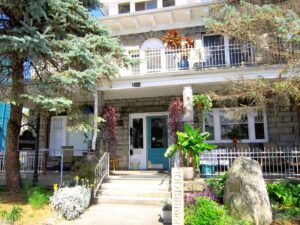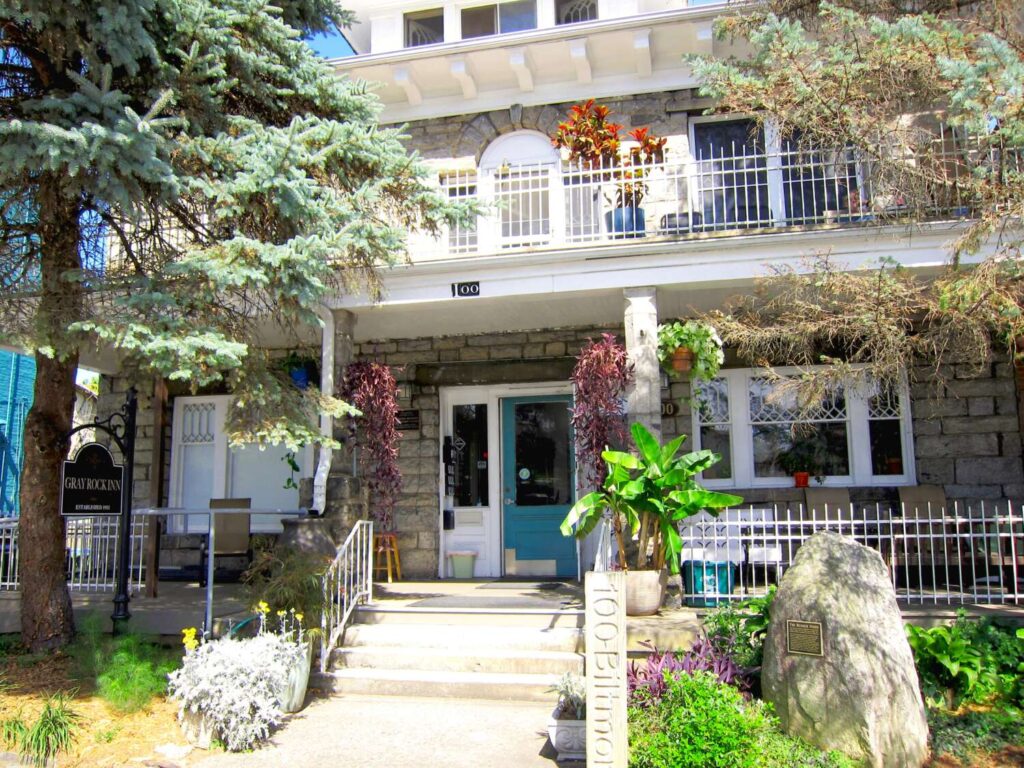The building was tired, but the bones were good.
In 2001, the Gray Rock Inn at 100 Biltmore Ave. in downtown Asheville was in bad shape with a leaking roof, termite damage, and falling plaster. It fronted the street with gray granite and a two-story sitting porch, not quite sheltered from passing traffic by four spruce trees. It needed a whole lot of TLC at first.
For 90 years, the building had served the area as a traveler’s inn, tourist home, boarding house, and rooming house. When it was built in 1911 at the turn of the 20th century, it was stylish and attractive. By the turn of the 21st century, it was rundown and failing.
Buildings in the U.S. account for 40 percent of total energy use. Since the 1970s, building codes have required increased insulation for energy conservation. A lot of older buildings, especially those from before 1950, have little insulation and are energy hogs, disproportionately contributing to the aforementioned 40 percent.
In 1911, there was little understanding about how to conserve or why one should bother. A hundred years later, excessive fossil fuel consumption is affecting the earth’s climate. Older buildings are allowed to continue under the grandfather loophole, and owners take advantage of it to leave wasteful facilities in place.

Strengths and weaknesses
The structure of the Gray Rock Inn was old, but its systems were restorable. Upgrading the building performance on older buildings can have a big impact. Yet, energy retrofits have value beyond just cost. The payoff is in making spaces more comfortable as well as more efficient. The comfort payback is immediate. The cost payback for insulation and conservation is just a few years.
Several features of this building are impractical to recreate today in new construction, like the 18-inch thick solid brick walls. Appraisers call this a “super adequacy,” meaning the extra masonry is so much more than enough, nobody does it like that anymore. It’s stronger than necessary and it would cost too much to build it today. With that much mass, there is a heat sink & flywheel effect keeping the building occupants cool in summer and warm in spring and fall. The bricks warm up during the day and release their heat at night. They are cool by morning, so in summer they moderate the daytime temperatures. But in the dark depth of winter when the bricks never warm up, the walls are always cold.
Coal was the fuel back when the inn was built. There was evidence of black coal dust in every crevice. The original coal furnace heated water and pumped it to radiators. A natural gas boiler supplies hot water to the radiators today.
The exterior masonry walls had no insulation at all. For this rehab, rigid foam insulation was added to the interior side of the outer brick walls in each room, one room at a time. Sheetrock covers it up, so it doesn’t look like anything has changed. Window jambs were extended to accommodate the extra wall depth.
All the windows were original from 1911. They were, as you would expect, in terrible condition. There were 24 double-hung windows, 6-feet tall with single-pane glass and broken ropes. A few lovely diamond pane windows on the front were in good enough shape to keep. All the windows leaked air around the wood frames.
They were replaced with new vinyl insulated double hung windows. It’s worth noting that the cheap replacement windows didn’t hold up over time very well. They are currently being replaced again with better quality windows. Still, they did the important job of stopping air leakage.
The diamond-pane windows facing the street remained in place, with new replacement windows installed directly behind them. The foam insulation on the walls and double-pane thermal windows helped so much, causing gas use to drop significantly.
Solar and salvage
The building has very good solar exposure to the south, which was an advantage for solar hot water panels. There was a great spot on the south side. The balcony wrapped around to a roof area that made a perfect place for tall water panels. It was just the right size for six 4-foot-by-10-foot used panels, recycled from their first home in Swannanoa. They were a fraction of the cost of new panels, and they fit nicely into place.
Scheduled annual maintenance is not usually necessary for a solar hot water system as is the case with furnaces. The moving parts are few, and there is no dangerous combustion. Solar water heaters are simple to maintain, though there could be an occasional pump or sensor breakdown that is easily repairable.
From the south-facing roof, these six panels send hot water to two 160-gallon tanks. From there preheated water is piped to a standard gas water heater, and then delivered to the residents for hot showers. On a clear day, the needs of 20 people are taken care of by the sun. On cloudy days, the water is heated by natural gas.
With all three measures in place (insulation, windows, and solar), gas use went down to 40 percent of the original volume as measured by CCFs (hundred cubic feet) of gas consumed.
A lot of recycled materials went into the rehab. Habitat ReStore provided some great parts. Fire doors came from the classifieds. The building is furnished with antique used tables, chairs, and dressers gleaned from local shops. Finishes are latex water-based no-VOC, except for floor paint which requires a harder coating. Pest control is with baits and traps. All light bulbs were replaced with compact fluorescent spiral bulbs until those became obsolete and were then replaced with LEDs.
Houseplants fill the common spaces. Landscape planting and water barrels around the building round out the exterior with natural beauty and water retention. At more than 110 years old, the building feels happy again and is restored to full functionality with updates for the next century.
John Senechal is a green builder and founding member of the WNC Green Building Council, now known as Green Built Alliance. His special interests are solar, community and real estate. General interests are gardening, dancing and peace. Connect with John at jasenechal@bellsouth.net.
Project Team:
Builder and Electrical — Bald Mountain Homes
Contractor — Building for Life
Architect — Glazer Architecture
Sprinkler System — Diboco Sprinklers
Solar Hot Water — Solar Dynamics
You can also view this article as it was originally published on page 22 of the 2022-23 edition of the directory.


